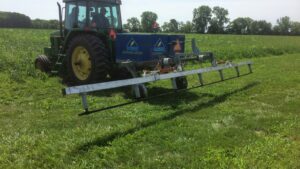There’s plenty of tools out there to help manage weeds on your operation, but unfortunately, it’s possible to overuse them.
Leaning too heavily on one element of weed control tools can lead to a breakdown of your operation, according to Liam Vincent, technical marketing manager for BASF.
As such, BASF’s Operation Weed Eradication is built on sound agronomic practices which include the following foundational pillars of cultural and mechanical practices, effective seed trait selection and chemical control, and eradication diligence.
On the seed side, herbicide tolerant crops have driven the trends for weed management over the last decade.
This strategy will likely continue to have a big impact as multi-stack technologies hit the market that allow multiple modes of action to be applied at the same time, increasing overall efficacy and control, says Matt Richmond, agronomist for Wilbur-Ellis.
The industry is also working to improve the accuracy of herbicide application, an additional layer of conservation.
As an example, “see and spray” technology is rapidly emerging and could drastically change how herbicides are applied.
“This technology only applies herbicide to actively growing weeds instead of a widescale broadcast application,” Richmond says. “But this technology is new and has a higher initial cost than broadcast application. It has yet to be widely adopted in the broad acre row crop market.”
Farmers are also facing herbicide shortages and supply delays, another reason that having an integrated weed management plan is important for the future of the industry so precision application may become more necessary.
Cost Considerations
Experts understand that weed management is a considerable input cost for growers.
“On average a midwestern corn farmer spends 7-10% of their yearly production costs on weed management, so investing just a couple of percent more each year will pay off for both near-term and long-term weed management sustainability,” says Kevin Gesse, head of product marketing for herbicides for Syngenta.
Jha says herbicide costs have increased significantly while adding cereal rye are a cover crop averages around $20-30 an acre.
“From an economic standpoint, some of the strategies make a lot of sense as well,” Jha says.
However, replacing equipment to accommodate reducing row spacing, or to add harvest weed seed control (HWSC) measures such as chaff lining or weed seed destruction, is an investment, and one that can be difficult to see returns in the first year.
Sustainability is typically a secondary factor, following cost.
“The new herbicides on the market with reduced rates, multiple modes of action and increased efficacy often take a back seat to cheaper off-patent generic chemistry,” Richmond says.
It’s important to keep the long-term goals in mind.
A multitactical approach may not pay you returns in the first or second year, but you are reducing the overall seed bank, and eventually, you’ll see lower costs of application for herbicides, according to Prashant Jha, professor and extension weed specialist at Iowa State University.
While there are many more strategies and technologies that can help you tackle weeds on your operation, these are just a few examples of how they can help.












